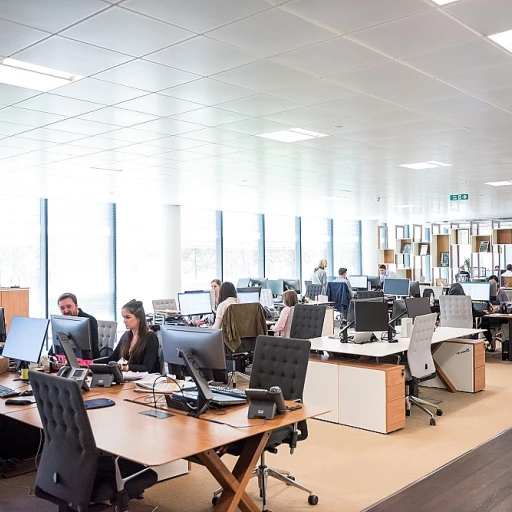
The Importance of Space Management in Indian Offices
The Crucial Role of Effective Space Utilization in Offices
In recent years, the strategic utilization of physical spaces in Indian offices has become a driving force for efficiency and productivity. Space management is now pivotal in accommodating not only the growing workforce but also the dynamic needs of today's businesses. With office real estate costs rising, ensuring optimal space utilization is more important than ever. One of the primary drivers for effective space utilization is the rise in multi-functional office layouts. Offices are evolving from traditional cubicles to flexible workspaces that can adapt real-time to meet varying demands. Implementing a space management system can facilitate this transition, allowing for seamless management of spaces. The impact of a space management system extends beyond mere space planning. It offers a data-driven approach to space utilization, enabling facility managers to make informed decisions. By analyzing patterns in space use, these systems assist in reallocating resources promptly, ensuring no square foot is wasted. Additionally, planning plays a critical role in managing office spaces efficiently. A well-thought-out course of action enables offices to navigate potential hazards associated with overcrowding or underutilization. By understanding human driving behavior patterns within the workplace, organizations can anticipate how to best configure space lanes to avoid bottlenecks. To delve deeper into enhancing office environments, explore our guide on enhancing productivity with optimal lighting in office cubicles. As the frontiers of office design and functionality expand, adopting defensive driving techniques and technology mirrors the needs of efficient space management. The integration of management software provides real-time insights into the utilization of both physical and digital spaces, allowing for a more streamlined and effective management landscape.Key Features of a Space Management System
Essential Components of Effective Systems
In today's competitive business environment, efficient utilization of office space is paramount. A well-designed space management system can significantly enhance the planning and usage of real estate, allowing companies to make the most out of their physical resources. Understanding the key features of such a system can help businesses drive more value from their facilities.- Real-time Data Collection: A robust space management system leverages real-time data to monitor space utilization. This dynamic capability enables businesses to adapt quickly to the ever-changing needs of their office spaces, ensuring optimal use of available resources.
- Advanced Planning Tools: These systems come equipped with planning software that assists in mapping out the most effective use of space. Through the analysis of data, managers can identify potential hazards related to space wastage and lane position inefficiencies in office layouts.
- Integration with Existing Infrastructure: Seamless integration with current IT systems is a crucial aspect. This integration supports the management of spaces without disrupting other operations, allowing for streamlined workflows and better defensive driving of resources.
- Automated Space Allocation: The system can facilitate automated path travel and allocate desk spaces as needed, ensuring business continuity without manual intervention. This automation enhances the space vehicle management process by optimizing the course of action.
- Vehicle Lane and Space Vehicle Tracking: In larger facilities, tracking the movement of vehicles and ensuring efficient lane positioning is vital for effective space management. The system supports tracking and planning movements within office spaces, enhancing overall productivity.
Benefits of Implementing Space Management Systems
Maximizing Space Utilization and Efficiency in Office Environment
Implementing an effective space management system in Indian offices offers a multitude of benefits that directly impacts business operations and the bottom line. As companies increasingly prioritize resource optimization, the role of space management systems becomes more crucial. By leveraging management software for space utilization, offices can achieve increased efficiency and effectiveness.
One of the core advantages of adopting space management systems is the enhanced real-time data insights they provide. By collecting information on how physical spaces are used, businesses can make informed decisions regarding office planning, leading to better allocation of space and resources. This functional data reveals usage patterns, allowing for adjustments that improve space usage and positioning of facilities.
The system also offers real-time monitoring and management of office spaces, ensuring that available areas are utilized to their full potential. This capability helps in reducing wasted space and increasing the occupancy rate of workspace. Furthermore, having precise control over management spaces aids in driving better decision-making around unnecessary extensions or costly real estate investments and ensures that facilities are available when and where needed.
Moreover, a well-deployed space management plan helps to streamline the path travel within an office. By capturing insights into lane position and car parks, these systems enable better vehicle and parking management, enhancing the overall office experience. This can directly influence driving behavior and defensive driving within impacted areas, allowing companies to address potential hazards on their premises proactively.
Implementing space management solutions can be a driving force in enhancing the efficiency of office operations, leading to tangible business benefits such as increased space utilization and reduced operational costs. As we consider the future trends of space management, it is essential to recognize its pivotal role in maintaining effective office environments and further improving workplace productivity.
For companies looking to understand more about maintaining workspace security, consider exploring ensuring secure visitor access in Indian companies.
Challenges in Adopting Space Management Systems
Challenges in the Path to Effective Space Management
Adopting space management systems in Indian companies can often be laden with challenges, despite the evident benefits. Understanding these potential hurdles can help businesses craft more targeted strategies for successful implementation.- Initial Costs and Investment: The real estate and office spaces in India usually require a considerable financial commitment when transitioning to advanced space management systems. This includes expenses related to facilities upgrades, software procurement, and training for staff to utilize these systems effectively.
- Resistance to Change: Both management and staff might resist the transition due to comfort with existing practices. Defensive driving behaviors, where current systems are preferred to new ones, can hinder progress.
- Integration with Existing Systems: For smooth operation, the new management software should seamlessly integrate with current workflow systems. Coordination issues can arise if the old frameworks are not compatible, affecting space utilization and planning.
- Data Management Concerns: Real-time data is essential for making informed decisions about space utilization. Companies might face challenges in setting up and maintaining the infrastructure necessary for capturing, storing, and analyzing this data.
- Space Utilization and Space Planning: Without proper understanding of the physical spaces and their potential hazards, inefficient planning can occur. Business leaders need to anticipate the roadway ahead, ensuring that the management space does not become chaotic during the transition.
Case Studies: Successful Implementations in India
Real-World Examples of Space Management Success
Implementing a robust space management system can transform the functionality and efficiency of Indian offices. Through real-world examples, we can observe the impact on space utilization, planning, and the overall management of physical spaces in a business environment. Here are a few case studies that showcase successful implementations:- Office Space Optimization: A leading IT firm aimed to enhance its office space utilization by integrating a space management system that provided real-time data on space occupancy and usage patterns. This allowed for effective space planning and allocation, significantly reducing idle spaces and improving overall efficiency. The management software facilitated defensive driving practices in navigating office layouts, enabling employees to reach their target areas promptly.
- Real Estate Management: In the realm of real estate, one prominent company deployed a management system to oversee multiple facilities and spaces across various locations. By having real-time insight into space utilization and occupancy rates, the firm improved its planning and decision-making processes. This approach served as a driving force in their business strategy, aligning lane position and path travel of office resources with strategic goals.
- Facility Vehicle Coordination: A corporate campus integrated a space management system to manage not only the office spaces but also the allocation of its fleet of space vehicles for employee transportation. With an effective space management strategy, the coordination of vehicles optimized lane positions, reduced potential hazards in roadway ahead scenarios, and led to reduced travel times. This holistic approach to facility management supported efficient course action and enhanced overall driving behavior within the office campus.












